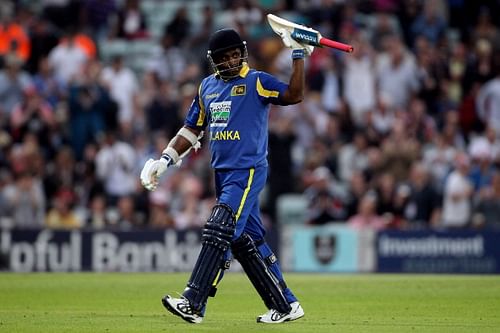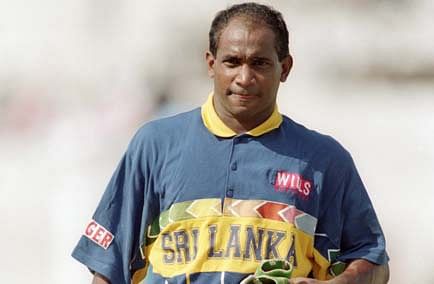
1996 World Cup Hero: Sanath Jayasuriya - Cricket’s Kamikaze

Losing your wicket in cricket is analogous to death in life. Mortality, despite being primordial, is something everyone loves to defer to eternity. Yet, you find heroes who embrace death, accept mortality and bid au revoir to life in order to die in honour for their motherland. Death is their ultimate glory; death is their supreme honour. Living an ordinary life is grievous. Dying in extraordinary fashion is glorious.
Getting out is what the indoctrinations in the nets tell you to avoid. Your presence at the crease is what is advocated above anything else, for a good technique in defence is what makes you a great batsman. Just ask Sunil Gavaskar, Rahul Dravid or Kumar Sangakkara.
Throwing the bat at everything is suicidal. Trying to pull all the stops to help your team score quickly is blind, senseless hitting. A six always has an element of risk behind it. Every time you aim for a big heave, you are staring death in its eyes.
Any batsman’s love of life is to remain unbeaten, for who can refrain from entertaining thoughts of batting a lifetime without getting out? Still, there are batsmen who find taking risks their calling. Hazards are something they love to hug in bed during their sleep. Precariousness is what gives them orgasms. Getting out for their team’s cause is what honours them.
Sri Lanka’s dream to conquer the world
Against a background of a great depression and a severe financial crisis in the post-World War I era, Japan realized it was time for change. They resuscitated their nationalistic beliefs of expansionism, which lead them to set out on a voyage to conquer Asia, for they believed that it was their “right to rule Asia”.
Entering the World Cup in 1996, Sri Lanka had scores to settle and mettle to be proven. Just months ago, they were subjected to sheer humiliation, first in the form of Muttiah Muralitharan being no-balled and then by being accused of ball-tampering. The Lankans became the silent recipients of swear words and verbal abuse.
In the first month of 1996, LTTE blew the Central Bank of Sri Lanka off. Shaken, the West Indies team refused to visit Sri Lanka. Australia, motivated by their political rift with the Sri Lankan government, used the terror attack to humiliate Sri Lanka on the world stage.
Leading Sri Lanka in the World Cup was Arjuna Ranatunga, who knew that the time was ripe for a change. He believed in the limited resources at his disposal and catalyzed them to turn his team from international punching bags to bare-knuckled street fighters. The time was right for Sri Lanka to stop fantasizing and start dreaming. It was time Sri Lanka tried to conquer the world.
Problems that embroiled Sri Lanka cricket at that time
Japan’s foray into world war proved fatal, as the Allied forces viciously approached their bases in Philippines. Defeat after defeat and humiliation after humiliation inundated Japan. Their aerial dominance was terminated. Their industries failed. Turmoil wrapped its arm around the archipelago.
Sri Lanka’s prior World Cup campaigns had produced only four wins in five world cups. The country possessed only one ground that could host a day-night match. Cricket in the island was limited to the capital city.
Politics embroiled cricket. Terror embattled politics. War tore into the north and east while terror deterred the south.
The captain of the Sri Lankan team had a fallout with the cricket board. Their premier spinner’s legality had come under scrutiny.
There was experience bedecking the line-up, yet positive results refused to materialize.
Sanath’s suicide missions

Dying in honour, death over defeat, capture and shame were deeply ingrained in Japan’s military culture. With defeat looming against the homeland, the Japanese refused to surrender.
Rear Admiral Masafumi Arima decided enough was enough. If their arms were not powerful enough to stop the adversaries from annihilating their chaste land, then they would use the flesh and blood – their mother nation conferred them with – to form a barricade. The Kamikaze pilots flying dive-bombers would plunge their vehicles straight into the foremast of heavy cruisers and flight-carriers.
‘Team above self’ was the mantra of the Sri Lankan team since time immemorial. The cricketers had no central contract and no guaranteed payments. The game was played for the love of cricket. Wearing the blue and yellow jersey was done in utmost pride.
The amateur team had professionals who could fight till the bitter end. They were one of the most inexperienced sides in the world, yet the lads were content with just playing cricket. Their dreams were miniscule and their hopes were dainty.
The likes of Roshan Mahanama, Hashan Tillakaratne and Arjuna Ranatunga provided the stonewall in the batting line up. Sri Lanka had a strong fortress but lacked paladins who could infiltrate enemy infantries. The defence was disproportionately strong while the offence lacked tooth.
Captain Ranatunga decided that it was high time that they started attacking. He turned Sanath Jayasuriya into cricket’s Kamikaze.
Jayasuriya’s wicket was to have no value while his role was to make teams question the value of their bowlers. The left-handed mauler would carry his heart on his sleeve and make bowlers fear the idea of bowling to him.
It was the element of surprise – bomb-shelling teams with wanton mayhem early in the innings, paralyzing them with shock and laying the coup de grace before they could recover.
Jayasuriya was not afraid to get out and he accepted his impending mortality with glee to give the much-needed barb at the top.
The Kamikaze era
The first Kamikaze mission was staged on the 15th of October, 1944. 100 Yokosuka D4Y bombers plummeted into an Essex-class aircraft carrier. That attack was preceded by a handful of unsuccessful ones. But once the assault on the flight carrier bore fruit, a number of other Kamikaze missions ensued, resulting in heavy causalities for the Allied forces
Mark Greatbatch was the first pinch-hitting opening batsman, but it is Jayasuriya who is accredited the honour of making it a brand in ODI cricket that re-wrote the game’s destiny.
The southpaw’s suicide missions didn’t yield positive results initially. He got out for six in the first game Sri Lanka played in the 1996 World Cup against Zimbabwe. However, the assignments that followed it were prosperous.
In the 24th match of the World Cup, Sri Lanka were pitted against India at the Feroz Shah Kotla, Delhi. A century to the genius Sachin Tendulkar meant that India put together a mammoth 271 runs.
When Sri Lanka began their innings chasing 272, India became the first victims of the Kamikaze attack in cricket. Jayasuriya, opening with Romesh Kaluwitharana launched an unprecedented attack on the new ball bowlers.
Manoj Prabhakar was hit the worst. His medium pacers were dispatched to all parts of the ground and he resorted to bowling off-breaks. The carnage wrecked by Jayasuriya left such an indelible scar on Prabhakar that he quit cricket soon after.
The score of 271 was made to look puny as the left hander raced to 79 off 76 balls. Even when, at long last, he got out, the virulence of his attack had demoralized the Indian attack to such an extent that a door for a comeback was always firmly shut.
In the game that succeeded against Kenya, the Lankan opener’s gratuitous arrogance set the stage for Sri Lanka to amass 398, then the highest ODI score. His 44 off 27 included three sixes and five fours which injected enough momentum for the middle order to sizzle through merrily.
Sri Lanka progressed to the quarterfinals unbeaten and had to face England. Darren Gough a decade later admitted that the dressing room was over the moon when they found Sri Lanka on their way.
Batting first in Faisalabad, England strolled to 235. But the English attack’s immunity against Jayasuriya’s devil-may-care slogs was nowhere to be seen, as the left handed dasher bashed 82 runs off 44 balls to make a mockery of the chase. The whole world was stunned as the islanders advanced to the semifinals.
The flipside of Kamikaze

Kamikaze is a double-edged sword. Although a successful attack can swing victory in your favour, a failure might be incredibly costly. In the semifinals against India at Kolkata, Jayasuriya died by his own sword. The untimely departure of both him and Kaluwitharana strangled Sri Lanka, who were left at two down for just one run in the first over.
In the finals too, Jayasuriya’s failure would continue. When the Allied forces strengthened their inoculation against Kamikaze, the attacks of the Japanese resulted in more loss for themselves than causalities for the foes. Eventually, though their delayed the chokehold of destiny wringing their wind pipes, they could not stop them entirely. Japan’s failure to combat conventionally proved to be fatal as they were forced to surrender.
But Sri Lanka’s conventional combative skills were nifty despite their foray into the unorthodox. Hence, even though the pinch-hitting suicide missions failed in the semi-finals and finals, Sri Lanka managed to romp home and win the Wills World Cup.
In the entire tournament Jayasuriya crossed fifty only twice. Out of the six games, only in three did he make substantial contributions. But it wasn’t the runs that mattered, but the way he got them that did. Here was a man who would rubbish conventions, thrash convictions, stare death in the eye and turn willow into a flail and flay all bowlers. Jayasuriya was quite aptly named the Man of the Tournament.
It is noteworthy that his slow left arm earned him seven wickets in the series, which were glossed over by his mastery with the bat. He is probably the only one in World Cup history to have bagged a man of the tournament without even featuring in the catalogue of highest run scorers or wicket takers.
The Kamikaze strategy in wars is now found only in war-lores. But cricket still thrives on its Kamikaze ploy, with it procreating a new format called T20, which in turn has begot a plethora of Kamikaze attackers like the Virender Sehwags, Chris Gayles and Tillakaratne Dilshans.
But it is Sanath Jayasuriya who was the original Kamikaze, and for that he will be remembered forever.